I’m writing this on the plane, flying home to Newark from an amazing four days in Northern California at the CNCH Conference. That would be the Conference of Northern California Handweavers for those not in the know… First, I can’t tell you how much it meant to me to be asked to teach at this particular conference. Eight years ago, I was scheduled to teach at CNCH 2002, and six weeks before the conference, with sold out classes, I was diagnosed with breast cancer. I had to cancel a number of teaching commitments that spring, and CNCH was one of them. Eight years went by without another invitation, and I always felt bad that I never had the opportunity to make up for having to cancel.
I taught four classes at the conference this past weekend, Friday morning I had a large group for my Photographing your Work seminar, followed by a class called Warp Fast, a seminar on warping techniques that involve methods using multiple threads, paddle warping, sectional warping, and using an AVL warping mill. I had a very large class for that seminar, and I got a lot of very positive feedback after both classes, which always makes me feel good, that I’ve inspired and encouraged others with new information and sometimes a new perspective. Friday night was of course, the fashion show. Always a conference favorite, I had a front row seat, which I appreciated, since I would be giving the technical critique of the garments on Sunday morning. I had spent Thursday afternoon previewing the garments as they came in, so I had a chance to look up inside, check construction details and techniques.
I had already sensed that there was something different about this conference, a different energy and enthusiasm I haven’t felt at a fiber conference in a very long time. The conference committee was doing an exceptional job, the facility, the Santa Clara Conference Center, attached to our hotel, the Hyatt, so we never had to leave the building, was first class, my classroom perfect for my needs, all my classes in one room, and the food at the Hyatt restaurants, outstanding and very reasonable.
So my weaving buddy, great friend and roommate Robyn Spady and I sat up front for the fashion show, and what a treat. I found the garments to be largely in one of two groups. There were a number of lovely jackets, beautifully tailored, made from exquisite handwoven, sometimes handspun and handdyed fabrics, and the makers of the garments, or their friends modeled them on stage. They were so proud of what they had done, and celebrated the moment. The show opened with the wedding ensemble, the year long undertaking of relatively new handweaver Tien Chiu, who has painstakingly documented every thread woven and every stitch taken on her blog.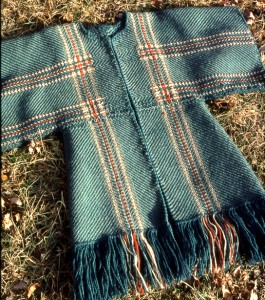
Then came the rectangles. A large percentage of the garments were quite the throw back to the 60’s and 70’s when handwoven clothing was a series of pieced together rectangles. Yet, there wasn’t a single bog jacket, that Bronze Age shape made from a couple of strategically place rectangles, based on the garments found in highly acidic boggy ground water. When I started making handwoven clothing in the late 1970’s the yarns available for the average handweaver were nothing like the yarns available today. Colors were classic, understated, and dyed more for rug weaving and tapestry than clothing. As a matter of fact, my art school, where I first learned to weave, had bins of rug yarn, and carpet warp for our use, and not much else. The first garment I ever wove was from a coarse wool, and it was actually a modified bog jacket.
Note: this photo, of a garment I did in 1976 represents how NOT to take a photo of your work!
Fast forward some thirty years and the yarns available to the average handweaver would blow your mind. We have the knitters to thank for that, and the brave spinners out there who have taken handspinning to a new level, spinning with the most amazing fibers that didn’t exist in the 1970’s, (like bamboo mixed with Angelina and soy silk) and the rectangles that are coming out of small simple looms are anything but classic. I’ve known that the knitting community has found handweaving and is embracing it with an excitement and an enthusiasm never before seen, but I hadn’t actually seen this phenomenon in action. Armed with the Knitter’s loom from Ashford, or the Rigid Heddle loom from Schacht, and some incredible yarn, in unbelievable color combinations, these new weavers are single handedly resurrecting the craft of handweaving, and taking it to levels I could have never imagined. And by young women half my age with pink hair wearing lime green hand knit socks they very competently knit themselves.
I don’t know if there is a Project Runway influence here as well, but the rectangular shapes of the garments that came parading across the runway were not the shapes of yore… I’m going under the assumption that since home ec is not part of the current curriculum in most schools in the US, that these amazingly talented young women are learning fashion skills somewhere else. The influence is pretty clear, since the rectangular clothing up on that stage was thoughtfully draped over someone’s body (a dressform?) and folded and tucked and seamed, stitched and embellished into some extremely creative clothing.
Alas, I have no pictures. I’m hoping the CNCH website will eventually provide some shots of the fashion show, but trust me to say that I was SOOOOO excited by what was in front of me. And in many of my classes, including the Saturday workshop on making a jacket pattern, there were numerous new weavers, first time conference attendees, and some amazing enthusiasm. The torch has been passed. And to my complete delight, the aging handweaving community seems to have opened its arms and embraced the new blood and the new creativity that has blown in like a fresh breath of air.
Keep in mind that this is California. In my travels, every new trend seems to originate here. It will probably take some time to make it across the country, but even in my discussions with the HGA Convergence Albuquerque committee, an international weaving conference happening in July of 2010, registrations have gone beyond all expectations. I have seen the future for handweaving and it is very very bright indeed.
Saturday night’s keynote address was given by Syne Mitchell. I first met Syne probably five years ago, a 30 something former Microsoft programmer with a very young son, she took my class in making a pieced vest in Seattle. Syne was a new weaver, coming from the knitting world with a huge background in technology. It didn’t take her long to find a need, and Syne jumped right in there to fill it. In a few short years, she has united the global handweaving community, connected them to the knitting community, and turned the fiber world upside down with her podcasts called Weavecast, (I’m episode 26) and her online weaving magazine Weavezine. ( I have agreed to write a monthly column on handwoven garments for Weavezine, stay tuned for that.) Weavecast has been listened to on six of the seven continents, still waiting for Antarctica to come on board. Syne gave a keynote that brought the global sources of handweaving found on the internet into the laps of everyone in the room. She showed the conference attendees what could be found with just a few keystrokes and a couple of URL’s. Online weaving publications, like Handwoven Weaving Weekly from Interweave Press; handweaving.net, developed by software engineer Kris Bruland with over 60,000 weaving drafts; Weavolution, an online global community of handweavers, blogs, and resources and information have revolutionized how we think, create, and interact with each other. Syne ended her keynote with some weaving karaoke that you had to be there to see, and she had the audience laughing with her through the entire address.
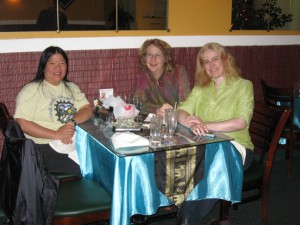 Keep in mind that this conference is right in the middle of Silicon Valley, and it isn’t just the 20 something pink haired knitters turned weavers armed with a drop spindle that are revolutionizing the handweaving community. Sunday night, after the conference was over, I went out to dinner with Syne and Tien Chiu, of wedding dress fame, and Tien’s significant other. I’ve always been one of the youngest of the handweaving community, having been trained in college and shortly after making a career of handweaving, but now, in my mid 50’s, I sat back listening to the discussions at the dinner table over Pad Thai and Ginger Chicken, about solenoids and dobby’s and software and 24 shaft looms, by two technologically savy women and a non weaving soon to be spouse of a weaver, and saw that the technologically trained programmers and software and web developers have not only found handweaving, but are running forward with the available technology at a speed that has left me in the dust. Tien is a web developer so it isn’t a surprise that she began her journey into handweaving finding a medium that would challenge and satisfy her amazing brain and blog about the journey so that others around the globe have followed the creation of the wedding dress, every intimate detail of it. Syne, Tien, and others like them are taking handweaving to places I never thought possible. It is all so very exciting, and I feel oddly enough like I’ve simultaneously gone back to my roots while feeling like I’m peering in the window of something truly wonderful and I want to come in and play too.
Keep in mind that this conference is right in the middle of Silicon Valley, and it isn’t just the 20 something pink haired knitters turned weavers armed with a drop spindle that are revolutionizing the handweaving community. Sunday night, after the conference was over, I went out to dinner with Syne and Tien Chiu, of wedding dress fame, and Tien’s significant other. I’ve always been one of the youngest of the handweaving community, having been trained in college and shortly after making a career of handweaving, but now, in my mid 50’s, I sat back listening to the discussions at the dinner table over Pad Thai and Ginger Chicken, about solenoids and dobby’s and software and 24 shaft looms, by two technologically savy women and a non weaving soon to be spouse of a weaver, and saw that the technologically trained programmers and software and web developers have not only found handweaving, but are running forward with the available technology at a speed that has left me in the dust. Tien is a web developer so it isn’t a surprise that she began her journey into handweaving finding a medium that would challenge and satisfy her amazing brain and blog about the journey so that others around the globe have followed the creation of the wedding dress, every intimate detail of it. Syne, Tien, and others like them are taking handweaving to places I never thought possible. It is all so very exciting, and I feel oddly enough like I’ve simultaneously gone back to my roots while feeling like I’m peering in the window of something truly wonderful and I want to come in and play too.
I do know how to spin, quite well actually, and I had a real desire to dust off my spinning wheel and find my drop spindle, 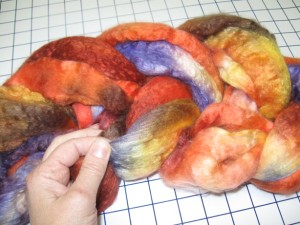 and try some of that wonderful colorful stuff available at the conference. I only had an hour or so to wander through the vast displays in the vendor hall, but I did manage to pick up some beautiful silk/mohair roving to spin, hand dyed in gorgeous purple and orange shades by Red Fish Dye Works, and in the back corner of the vendor hall, at the booth next to the pen with three alpacas, I bought the first fleece from
and try some of that wonderful colorful stuff available at the conference. I only had an hour or so to wander through the vast displays in the vendor hall, but I did manage to pick up some beautiful silk/mohair roving to spin, hand dyed in gorgeous purple and orange shades by Red Fish Dye Works, and in the back corner of the vendor hall, at the booth next to the pen with three alpacas, I bought the first fleece from 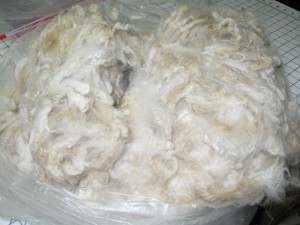 Montana, a baby Alpaca, and I’m going to start spinning some yarn. It was hard not to get caught up in the new enthusiasm of the future of handweaving, and to my great delight, in addition to all of the wonderful things to spin and weave and knit available at the conference, there was a Janome sewing machine dealer who was doing quite the brisk business selling sewing machines. I heard more than one person telling me about retiring that old Singer from 1940 and moving on to something that would inspire creativity and get them sewing again. Along with the rebirth of handweaving is the potential for a rebirth in the sewing world as well. Which makes my heart sing, since I keep a foot in both worlds. I weave cloth, to sew into clothing, and suddenly the possibilities have exploded and I couldn’t be happier. I have seen the future and it is indeed bright.
Montana, a baby Alpaca, and I’m going to start spinning some yarn. It was hard not to get caught up in the new enthusiasm of the future of handweaving, and to my great delight, in addition to all of the wonderful things to spin and weave and knit available at the conference, there was a Janome sewing machine dealer who was doing quite the brisk business selling sewing machines. I heard more than one person telling me about retiring that old Singer from 1940 and moving on to something that would inspire creativity and get them sewing again. Along with the rebirth of handweaving is the potential for a rebirth in the sewing world as well. Which makes my heart sing, since I keep a foot in both worlds. I weave cloth, to sew into clothing, and suddenly the possibilities have exploded and I couldn’t be happier. I have seen the future and it is indeed bright.
This morning, I had breakfast with Nancy Weber, one of the key organizers 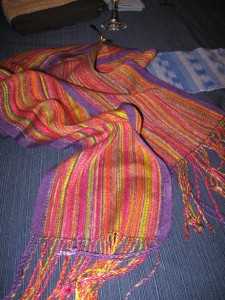 of the conference, and she showed me the “conference scarf”, woven by a committee of weavers, as a gift for all the organizers. It was based on my weaving buddy and guild mate Sally Orgren’s article in Handwoven Magazine, Nov/Dec 2008, on eight shaft and
of the conference, and she showed me the “conference scarf”, woven by a committee of weavers, as a gift for all the organizers. It was based on my weaving buddy and guild mate Sally Orgren’s article in Handwoven Magazine, Nov/Dec 2008, on eight shaft and 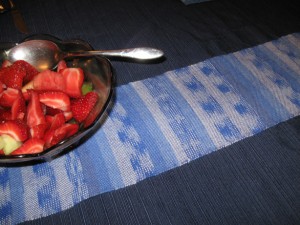 four shaft dimity. Can I say they were exquisite? The colors were hand dyed, and can I say I coveted one? I have a loom, I have tencel, and I have that issue of Handwoven Magazine. In addition, the table runner across the breakfast table in Nancy’s home was woven from self patterning sock yarn. Who knew? The beautiful ikat effects were just yarn that was engineered to pattern a pair of socks. My head is spinning with possibilities. These are perfect projects to put on all my baby Structo looms. Can you tell it was a mind blowing weekend? So now I’m heading back to NJ, on my last leg of the trip, sitting in first class, with my wine, and thinking that life is really good. And the future is very bright indeed…
four shaft dimity. Can I say they were exquisite? The colors were hand dyed, and can I say I coveted one? I have a loom, I have tencel, and I have that issue of Handwoven Magazine. In addition, the table runner across the breakfast table in Nancy’s home was woven from self patterning sock yarn. Who knew? The beautiful ikat effects were just yarn that was engineered to pattern a pair of socks. My head is spinning with possibilities. These are perfect projects to put on all my baby Structo looms. Can you tell it was a mind blowing weekend? So now I’m heading back to NJ, on my last leg of the trip, sitting in first class, with my wine, and thinking that life is really good. And the future is very bright indeed…